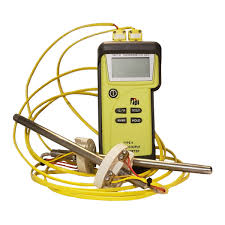How to Use a Pyrometer for Accurate Temperature Measurement
When it comes to measuring temperature in various applications, precision is key. Enter the pyrometer a remarkable tool that plays a crucial role in industries ranging from manufacturing to scientific research. Whether you’re working with molten metal or monitoring furnace temperatures, understanding how to effectively use a pyrometer can make all the difference.
In this article, we’ll explore what exactly a pyrometer is, why accurate temperature measurement matters, and how you can master its use for optimal results. Get ready to dive into the world of precise thermal readings!
What is a Pyrometer?
A pyrometer is a specialized instrument designed to measure high temperatures, often without needing direct contact with the object being measured. Its name comes from the Greek words “pyro,” meaning fire, and “metron,” meaning measure.
Typically used in industrial settings, pyrometers are essential for monitoring processes where traditional thermometers would be impractical or unsafe. They utilize various principles of physics, such as infrared radiation or thermal emission, to gauge temperature accurately.
There are two main types: contact and non-contact pyrometrs. Contact versions require physical touch with the object, while non-contact models can read temperatures from a distance—ideal for hot surfaces like metals or molten glass.
Their versatility makes them invaluable in fields ranging from metallurgy to ceramics and even food processing. Understanding how they work opens up new possibilities for improved efficiency and safety across industries.
The Importance of Accurate Temperature Measurement
Accurate temperature measurement is crucial across various industries. Whether in manufacturing, food processing, or scientific research, precise readings can make all the difference.
In many processes, even a slight deviation can lead to product failure or safety hazards. For instance, in metallurgy, incorrect temperatures during metal forging can weaken the final product.
Moreover, maintaining optimal conditions ensures efficiency and energy savings. In HVAC systems or industrial ovens, accurate monitoring prevents overheating and minimizes waste.
In healthcare settings, temperature plays a vital role in patient care. Monitoring body temperature accurately helps diagnose infections early on.
Knowing the exact temperature fosters better decision-making. It enhances quality control and boosts overall productivity by minimizing errors associated with misreading temperatures.
Types of Pyrometers
Pyrometers come in various types, each designed for specific applications and temperature ranges.
The most common type is the infrared pyrometer. It measures temperature from a distance by detecting the thermal radiation emitted by an object. This makes it ideal for moving targets or hazardous environments.
Then there are contact pyrometrs, which require direct contact with the material to measure its temperature accurately. These are often used in laboratory settings where precision is crucial.
Another variant is the optical pyrometr, primarily used for high-temperature measurements in industrial processes. They rely on visual wavelengths and can be very effective when used correctly.
Each type has unique features tailored to different needs, making understanding them vital for anyone who requires precise temperature measurement.
How to Use a Pyrometer
Using a pyrometer is straightforward, but precision is key. Start by selecting the right type of pyrometer based on your application—contact or non-contact.
For contact pyrometers, ensure that the probe makes direct contact with the surface you’re measuring. Insert it firmly for an accurate reading but avoid damaging the material.
When using a non-contact infrared pyrometr, aim at the target from a safe distance. Hold it steady to prevent any fluctuations in temperature readings.
Make sure to adjust settings according to emissivity values if necessary. This adjustment compensates for different materials and surfaces, ensuring reliability.
Allow some time for stabilization before recording your measurement. A little patience can lead to much more reliable data!
Tips for Accurate Temperature Readings
To achieve precise temperature readings with a pyrometer, start by ensuring that your instrument is properly calibrated. Regular calibration helps maintain accuracy over time.
Next, consider the emissivity of the surface you are measuring. Different materials emit infrared radiation differently. Adjust the emissivity setting on your pyrometr to match the material for better results.
Maintain a steady distance from the target surface when taking measurements. A consistent distance ensures that you’re capturing an accurate reading without interference from surrounding temperatures.
Avoid measuring through glass or other transparent materials; they can distort readings significantly. If necessary, use a non-contact method where possible.
Protect your pyrometer from environmental factors like dust and moisture during use. Keeping it clean enhances its lifespan and reliability in delivering accurate readings every time.
Common Mistakes to Avoid When Using a Pyrometer
Using a pyrometer can greatly enhance your temperature measurement accuracy, but common mistakes can undermine this potential. One frequent error is not accounting for emissivity. Different materials emit infrared radiation differently, and failing to adjust for this can lead to incorrect readings.
Another mistake is using the wrong type of pyrometer for your specific application. Each type has its strengths; choosing one that doesn’t suit your needs may yield inaccurate results.
Improper positioning of the device also leads to errors. Ensure that you hold the pyrometer at the correct angle and distance from the surface being measured.
Ignoring environmental factors like dust or smoke can affect readings too. Always check if these elements might interfere with accurate measurements.
Neglecting regular calibration checks will compromise performance over time. Make it a habit to calibrate regularly for optimal accuracy in every measurement session.
Applications of Pyrometers
Pyrometers are essential tools in various industries. They measure high temperatures without contact, making them perfect for demanding environments.
In metalworking, pyrometers help monitor the heat of molten metals. This ensures that materials are processed at optimal temperatures, enhancing quality and safety.
Glass manufacturing also relies on these devices to maintain precise thermal conditions during production. Accurate readings prevent defects in glass products by avoiding overheating or underheating.
Food processing facilities utilize pyrometrs to ensure compliance with food safety standards. Monitoring cooking temperatures accurately helps eliminate harmful bacteria while preserving flavor and texture.
Moreover, pyrometrs find applications in power generation. They monitor furnace and boiler temperatures to improve efficiency and reduce emissions in energy plants.
From aerospace engineering to automotive testing, the versatility of pyrometrs is evident across many sectors where temperature control is critical for performance and safety.
Conclusion
Accurate temperature measurement is crucial across various industries. A pyrometer can be an invaluable tool in achieving this accuracy. By understanding how to use it effectively, you can enhance your operations and ensure safety.
The importance of precise readings cannot be overstated. Whether you’re involved in manufacturing, metallurgy, or even cooking, knowing the exact temperature can impact quality and efficiency.
Different types of pyrometers cater to specific needs. Selecting the right one for your application will yield better results.
Utilizing a pyrometer involves some straightforward steps that are easy to follow once you familiarize yourself with the device’s features and settings.
Taking extra care with certain tips can significantly improve your readings. Simple adjustments in technique often make all the difference.
Avoiding common mistakes ensures reliability in your measurements. Awareness of these pitfalls enhances overall performance when using a pyrometer.
Pyrometers find applications across numerous fields—from industrial processes to scientific research—demonstrating their versatility and significance.
Embracing this technology equips you with the tools necessary for precision work while expanding potential avenues for innovation within your industry.





